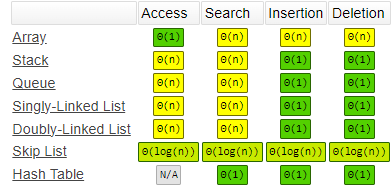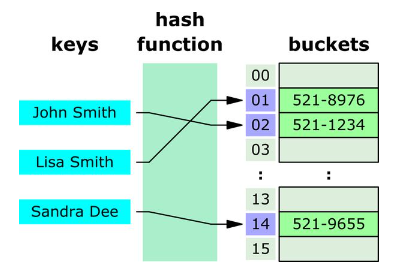# 一、哈希表
# 1、认知
哈希表通常是基于 数组 进行实现的,但是相对于数组,它可以非常快速的进行 插入-删除-查找 操作
其核心就是:生成一个与数据项相关联的 下标值,这样就可以快速的查找数据项了。
# 2、特点
哈希表的产生,肯定是为了解决一些问题:
如下图,Hash Table 在进行 插入-删除-查找 时,相对于数组、链表而言,效率就高得多
应用场景
比如:现在公司要求你存储 1000 个员工的姓名,但直接使用数组时,查找效率会非常低。

# 二、哈希索引获取
参考:https://medium.com/@edwin.cloud/hash-tables-simplified-93e378b7a3e8
# 1、核心思路
哈希表是一种数据结构,用于存储键值对(key-value),其方式可以通过使用哈希函数生成的特定索引(hashIndex)(称为哈希)快速访问。
# 1、哈希冲突
- 开放地址法:寻找空白的单元格来放置冲突的数据项
线性探测(+1、聚集问题)、二次探测(+n)、再哈希法(
constant - ( key % constant))
- 链地址法
拓展:效率(填充因子(
N / arrayLength))、扩容、质数
提示
Java 中的 HashMap 采用的就是链地址法。其hashIndex的计算公式为:
hashIndex = hashCode & (length - 1) # 可以通过变化(length - 1)进行扩容
# 2、霍纳法则
我们可以使用 幂的连乘 的方式将带存储的数据转换为 数字(哈希值),但其值可能会变得很大。
所以,我们可以通过通过霍纳法则(中国称之为秦九韶算法),可以将时间复杂度从 O(N²) 下降到了 O(N)。
N 次幂的底数,这里我们选则 质数 31 (分离分别更均匀,也建议使用质数)
# 数据:Jay --> 74 97 121 # 编码转换(可以选择任意的编码方案(ASCII等),甚至是自定义的编码系统)
# 幂的连乘
74 * 31² + 97 * 31¹ + 121 # O(N²)
# 霍纳法则 ✨
((74 * 31) + 97) * 31 + 121 # O(N)
提示
通过霍纳法则,我们可以更为巧妙的得到 hashCode
hashCode = 31 * hashCode + key.charCodeAt(i)
# 3、哈希函数
图示:

- 编写获取 hashIndex 的函数
/**
*
* @param key 每一个item项的数据值
* @param length 设置的哈希表的长度
* @returns
*/
export function generateHashIndex(key: string, length: number = 7): number {
let hashCode = 0
for (let i = 0; i < key.length; i++) {
// 霍纳法则
hashCode = 31 * hashCode + key.charCodeAt(i) // 使用的是ASCII码
}
const hashIndex = hashCode % length
return hashIndex
}
- 测试示例
import { generateHashIndex } from '../HashTable'
// 填充因子loadFactor = 6 / 11 = 0.54...
console.log(generateHashIndex('xxx', 11)) // 8
console.log(generateHashIndex('iii', 11)) // 7
console.log(generateHashIndex('jjj', 11)) // 10
console.log(generateHashIndex('fff', 11)) // 9
console.log(generateHashIndex('www', 11)) // 5
console.log(generateHashIndex('vvv', 11)) // 2
# 三、设计实现
参考:https://www.freecodecamp.org/news/javascript-hash-table-associative-array-hashing-in-js/
# 1、哈希表结构
通过上面的哈希函数获取 buckets 的 hashIndex,其中 bucket 有我们传入的 key 和 value 组成
value 是我们真正的数据,而 key 值可以随便写(与数据相关联即可,类似于对象),通过 key 我们可以获取到 hashIndex,进而获取到存储 value 对应的 bucket

# 2、哈希表设计
根据上图,我们可以构建哈希表如下:
class HashTable<T = any> {
// 数组的用于链式存储bucket的链(数组)
private buckets: [string, T][][] = []
// 数组中已存放的bucket个数
private count: number = 0
// 数组的长度
private length: number = 7
// 提示:填充因子 loadFactor = count / length,当loadFactor>0.75时,我们会进行扩容操作
}
export default HashTable
# 3、哈希表实现
class HashTable<T = any> {
// ……
// ---
// -----------------------
// -----------------------
// 根据 key 生成对应的 hashIndex索引
private generateHashIndex(key: string, length: number = 7): number {
let hashCode = 0
for (let i = 0; i < key.length; i++) {
// 霍纳法则
hashCode = 31 * hashCode + key.charCodeAt(i) // 使用的是ASCII码
}
const hashIndex = hashCode % length
return hashIndex
}
// -----------------------
// -----------------------
// 1、插入/修改
put(key: string, value: T) {
// 生成hashIndex索引
const index = this.generateHashIndex(key, this.length)
// 找到对应的bucket
let bucket = this.buckets[index]
// 1、bucket无值的情况 -- 判断bucket是否有值(判断是否链式追加)
if (bucket === undefined) {
bucket = []
this.buckets[index] = bucket
}
// 2、更新key的情况 -- 判断是追加还是覆盖
let isUpdate = false
for (let i = 0; i < bucket.length; i++) {
const tuple = bucket[i]
const tupleKey = tuple[0]
if (tupleKey === key) {
tuple[1] = value
isUpdate = true // 标记一下
}
}
// 3、新增key的情况 -- 判断是追加还是覆盖
if (!isUpdate) {
bucket.push([key, value])
this.count++
}
}
// 2、获取
get(key: string): T | undefined {
// 生成hashIndex索引
const index = this.generateHashIndex(key, this.length)
// 找到对应的bucket
let bucket = this.buckets[index]
// 1、bucket无值的情况
if (bucket === undefined) return undefined
// 2、遍历bucket
for (let i = 0; i < bucket.length; i++) {
const tuple = bucket[i]
const tupleKey = tuple[0]
if (tupleKey === key) {
return tuple[1]
}
}
}
// 3、删除
delete(key: string): T | undefined {
// 生成hashIndex索引
const index = this.generateHashIndex(key, this.length)
// 找到对应的bucket
let bucket = this.buckets[index]
// 2、遍历bucket
for (let i = 0; i < bucket.length; i++) {
const tuple = bucket[i]
const tupleKey = tuple[0]
if (tupleKey === key) {
bucket.splice(i, 1)
this.count--
return tuple[1]
}
}
}
// ---
}
# 4、哈希表扩容
class HashTable<T = any> {
// ……
// ---
// -----------------------
// -----------------------
// 根据指定的newLength长度进行 扩容/缩容 操作
private resizeChange(newLength: number) {
const oldBuckets = this.buckets
let newPrime = newLength
// newLength 最小值约束
if (newPrime < 7) newPrime = 7
// 确保传入的是一个质数
while (!this.isNewLengthPrime(newPrime)) {
newPrime++
}
// console.log(newPrime)
this.length = newPrime
this.buckets = []
this.count = 0
// 重新存放数据
oldBuckets.forEach((bucket) => {
if (!bucket) return
for (let i = 0; i < bucket.length; i++) {
const tuple = bucket[i]
this.put(tuple[0], tuple[1])
}
})
}
// 判断传入的newLength是否为质数
private isNewLengthPrime(newLength: number) {
const sqrt = Math.sqrt(newLength)
for (let i = 2; i <= sqrt; i++) {
// 判断是否能被除了 1 和 sqrt 以外的数 整除
if (newLength % i === 0) {
return false
}
}
return true
}
// -----------------------
// -----------------------
// 1、插入/修改
put(key: string, value: T) {
// ……
// 3、新增key的情况 -- 判断是追加还是覆盖
if (!isUpdate) {
bucket.push([key, value])
this.count++
// 是否进行扩容操作
const loadFactor = this.count / this.length
if (loadFactor > 0.75) {
this.resizeChange(this.length * 2)
// console.log(this.buckets)
}
}
}
// 3、删除
delete(key: string): T | undefined {
// 生成hashIndex索引
const index = this.generateHashIndex(key, this.length)
// 找到对应的bucket
let bucket = this.buckets[index]
// 2、遍历bucket
for (let i = 0; i < bucket.length; i++) {
const tuple = bucket[i]
const tupleKey = tuple[0]
if (tupleKey === key) {
bucket.splice(i, 1)
this.count--
// 是否进行扩容操作
const loadFactor = this.count / this.length
if (loadFactor < 0.25 && this.length > 7) {
this.resizeChange(Math.floor(this.length / 2))
// console.log(this.buckets)
}
return tuple[1]
}
}
}
// ---
}
